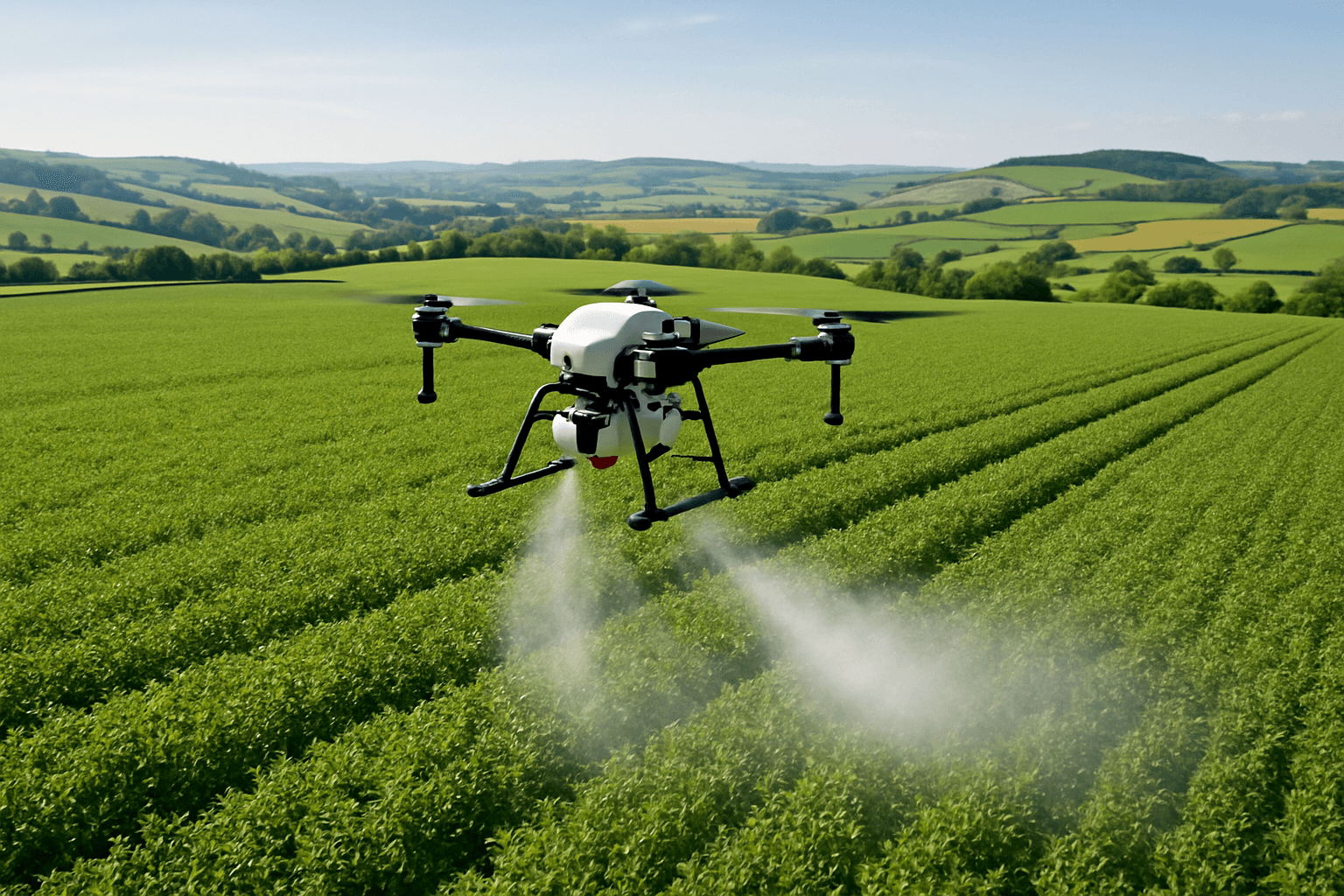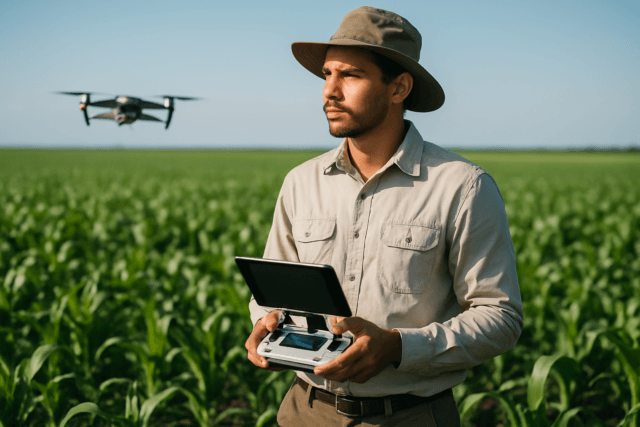Drone spraying is rapidly transforming UK agriculture, offering a more efficient, precise, and environmentally conscious approach to crop management. This innovative technology utilizes unmanned aerial vehicles (UAVs) to apply pesticides, herbicides, fertilizers, and other treatments to agricultural fields. With the potential to increase yields, reduce costs, and minimize environmental impact, drone spraying is poised to revolutionize traditional farming practices.
What is Drone Spraying?
Drone spraying, also known as agricultural drone spraying, involves using UAVs to apply various substances to crops. These drones are equipped with tanks to carry liquids or granular products and spraying mechanisms designed for even distribution. GPS and mapping software are used to program flight paths ensuring accurate coverage. Flying at low altitudes, drones apply treatments through nozzles installed on their arms. Sensors and cameras monitor crop conditions and adjust application rates in real-time.
Benefits of Drone Spraying
Drone spraying offers a multitude of advantages over traditional methods:
- Precision and targeted application: Drones can pinpoint specific problem areas, reducing the overall volume of chemicals used and minimizing waste.
- Reduced chemical use: Drone spraying can reduce pesticide use by up to 30%, resulting in significant reductions in chemical runoff and soil contamination.
- Environmental protection: The precise application of pesticides minimizes their impact on the surrounding environment, preserving biodiversity and protecting ecosystems.
- Improved worker safety: Drones minimize the need for direct human handling of agricultural chemicals, lowering potential health risks.
- Access to challenging terrains: Drones can operate in steep or irregular fields, providing access that traditional equipment may find difficult.
- Reduced soil compaction: Drones eliminate the need for heavy machinery on the field, reducing soil compaction and preserving soil health.
- Time and labor savings: Drones can cover large areas quickly and efficiently, freeing up human resources for other important tasks.
- Cost-effectiveness: By streamlining operations and minimizing waste, drone spraying solutions can deliver significant cost savings and efficiency gains.
- Increased crop yields: Drones can improve crop yields by delivering precise application of fertilizers and pesticides.
- Data collection and analysis: Drones are equipped with advanced data-collection capabilities, providing insights for optimizing farming strategies.
- Efficient crop monitoring: Drones allow farmers to monitor large areas of farmland quickly and efficiently, identifying issues like pest attacks, diseases, or water stress at an early stage.
How Drone Spraying Works
Drone spraying involves several key steps:
- Field assessment and mapping: A thorough assessment of the field is conducted to identify problem areas and create a custom application plan. High-resolution imagery and GPS coordinates are used to pinpoint specific areas needing treatment.
- Flight planning: Automated flight paths are programmed into the drone to ensure precise coverage and optimal spraying efficiency.
- Spraying execution: The drone automatically flies to and sprays the designated areas, using radar to maintain a set height above the crop and adjusting its flow rate based on speed.
- Post-application assessment: A post-application assessment is conducted to verify the treatment’s effectiveness and document the results.
Types of Drone Spraying
There are two main categories of agricultural spraying drones:
- Broadcast spraying drones: These drones administer herbicides or pesticides over a larger area, such as an entire field. They are typically used for non-selective weed or pest control when the area needs treatment.
- Spot spraying drones: These drones selectively apply herbicides or pesticides directly to areas infested with weeds or pests. Smaller drones are particularly effective for spot treatments and niche applications, reducing chemical usage by targeting only the infected areas.
Types of Drones Used for Spraying
Various types of drones are used in agriculture, each with its own advantages and limitations:
- Multi-rotor drones: These drones are highly maneuverable and can fly in any direction, making them ideal for close-range operations such as crop monitoring and analysis.
- Fixed-wing drones: These drones are designed to cover vast expanses of land efficiently. Their speed and endurance make them ideal for surveying expansive regions and collecting comprehensive data.
- Hybrid drones: These drones combine the features of both fixed-wing and rotary-wing designs, offering greater range and flight time than either type alone. They are used for a variety of purposes, including crop mapping, crop scouting, and pesticide spraying.
Regulations and Legal Considerations in the UK
While drone spraying offers numerous benefits, it’s essential to be aware of the regulations and legal considerations in the UK:
- Permits: The Health and Safety Executive (HSE) does accept requests to permit the application of pesticides by drone, but this is judged on a case-by-case scenario.
- Application plan: Anyone carrying out aerial spraying must ensure that spraying is done in line with an approved Application Plan.
- Operator ID and Flyer ID: If a drone weighs more than 250g, it is against the law to fly it without having the required IDs.
- Visual line of sight (VLOS): Pilots must maintain a visual line of sight with their drones at all times without using any visual aids.
- Privacy laws: When flying drones equipped with cameras, operators must comply with privacy laws, including not capturing images of people without their consent and avoiding areas where privacy is expected.
Potential Challenges and Limitations
Despite its potential, drone spraying also faces several challenges and limitations:
- Limited payload capacity: Drones often carry smaller amounts of chemicals per flight, requiring frequent refilling and battery swaps.
- Flight time: Flight times typically range from 10 to 25 minutes, constraining efficiency for larger fields.
- Weather dependency: Drones are susceptible to weather conditions such as wind and rain, which can affect their performance.
- High initial investment: The cost of purchasing a drone and related equipment can be a barrier for some farmers.
- Technical skills required: Operating a drone requires technical skills and training.
Environmental Impact of Drone Spraying
Drone spraying offers several environmental benefits compared to traditional methods:
- Reduced carbon emissions: Drones run on rechargeable batteries, reducing the need for diesel-powered machinery and lowering fuel consumption.
- Reduced chemical runoff: Targeted spraying helps to limit chemical runoff and reduce environmental exposure.
- Protection of wildlife: Drones help protect wildlife by minimizing the environmental impact of farming.
- Water conservation: Drones equipped with thermal imaging sensors help farmers implement precise irrigation strategies, addressing water scarcity concerns.
Drone Spraying vs. Traditional Methods
Here’s a comparison of drone spraying and traditional methods:
Okay, I can help you fix and improve this table. The main areas for improvement are conciseness, direct comparability, and ensuring each point is distinct.
Here’s a revised version of the table:
| Feature | Drone Spraying | Traditional Methods |
| Precision | High precision using GPS & GIS for targeted application; minimizes chemical waste. | Less precise; broader application with higher risk of chemical drift. |
| Coverage | Efficient for small, irregular fields; adaptable to varied terrain. | More efficient for very large, uniform fields; can carry larger chemical volumes. |
| Cost | Lower initial investment than manned aircraft; reduced chemical usage saves money. | High initial equipment costs; potential for higher long-term chemical expenses. |
| Environmental Impact | Minimizes chemical drift and off-target impact; reduces direct human chemical exposure. | Higher risk of chemical drift affecting non-target areas; greater human exposure risk. |
| Labor | Reduces need for manual field labor; can be operated by a single trained person. | Often requires multiple operators for machinery and application. |
| Soil Compaction | No soil compaction as it operates airborne. | Heavy ground machinery can cause significant soil compaction. |
| Crop Damage | No direct contact with crops, avoiding physical damage. | Machinery can cause physical damage to crops during application. |
| Terrain Adaptability | Highly adaptable to difficult or uneven terrain. | Limited by terrain accessibility for heavy machinery. |
| Speed of Deployment | Rapid deployment and setup for targeted applications. | Can be slower to deploy for smaller or varied plots due to machinery logistics. |
| Data & Analytics | Can integrate with sensors for data collection (e.g., crop health monitoring). | Less inherent capability for integrated data collection during application. |
Companies Offering Drone Spraying Services in the UK
Several companies offer drone spraying services in the UK:
- AutoSpray Systems Ltd: A UK leader in commercial drone agriculture, offering spraying, spreading, and seeding services.
- FarmDronesUK: Provides a range of professional drone services to help increase yields, optimize processes, and reduce environmental footprint.
- SAS Land Services: Offers drone-based spreading and spraying of seeds, fertilizers, and other non-regulated products.
- Precision Drone Services (PDS): Delivers cutting-edge drone technology for rejuvenating failing crops, improving yields, and ensuring effective shading for greenhouses.
- Precision Drone Spray: Offers innovative crop spraying solutions designed to enhance efficiency and sustainability in agriculture.
- AgriDrone Services: Specializes in precision farming aerial solutions, including crop scouting, surveying, spraying, and spreading.
- Swarm Ops: Provides drone spraying services, drone greenhouse shading contractors, and seeding and spreading.
The Future of Drone Spraying
The future of drone spraying in the UK is bright, with ongoing innovations promising to enhance battery life, payload capacity, and the development of drone-based biocontrol methods. As the agricultural industry continues to adapt and innovate, the adoption of drone pesticide applications is expected to rise, providing a safer, more efficient, and environmentally conscious solution to pest management.
With careful planning, management, and evaluation, drone spraying has the potential to revolutionize the agricultural sector, promoting efficiency, sustainability, and productivity, while minimizing environmental impact and human health risks.





